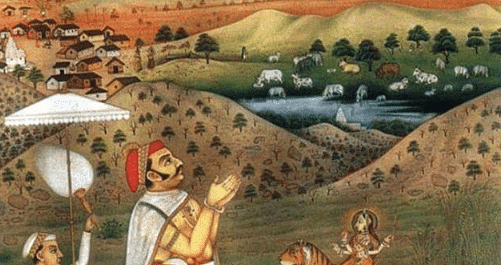RPSC RAS (Rajasthan) Exam > RPSC RAS (Rajasthan) Notes > Course for RPSC RAS Preparation > Guhil Dynasty of Mewar
Guhil Dynasty of Mewar | Course for RPSC RAS Preparation - RPSC RAS (Rajasthan) PDF Download
The Kingdom of Mewar
- The kingdom of Mewar includes present day districts of Chittorgarh, Rajsamand, Udaipur, Dungarpur, Banswara. The region was originally called Medhpaat and Lord Shiva (Ekling Nath) is called Medhpateshwar (Lord of Medhpaat). Over time, the name Medhpath became Mewar.

- The creators of Mewar’s ruling dynasty in Rajputana came originally from the Guhilot clan. Foundation stories claim this clan originated in Kashmir and migrated to Gujarat in the sixth century. In the seventh century they migrated again, to the plains of Mewar, in the area around Magda, which was named after one of the earliest clan leaders.
Guhils of Chittorgarh
- Guhil
- He is known as the founder of Guhil dynasty.
- Originally he was born in Anandnagar, Gujarat but in 565 C.E, he established independent city at Nagda (Udaipur).
- Bappa Rawalbappa
- Born as Kalbhoj
- Is said to have defeated Maan Mori and laid foundation of Guhilot Dynasty rule in Mewar.
- Formed triple alliance with Nagabhatta & Jaysimha to defeat Arabs in Battle of Rajasthan.
- Khumar (753 – 773 )
- Mattat (773 – 793 )
- Bhratrabhat (773 – 813 )
- Sinha (813 – 828)
- Khuman II (828 – 853)
- Repelled up to 24 Muslim attacks.
- Ruled a Golden Age in Mewar.
- Mahayak (853 – 878)
- Khuman III (878 – 942)
- Bhratrabhat II (942 – 943)
- Allat (943 – 953)
- Possibly near start of his reign, Allat is driven from Chittor by the Paramara king of Malwa, Munja Raja, who then rules Chittor and is succeeded by his nephew, Raja Bhoj. Allat establishes a new capital at ancient Ahar.
- (953 – 971) – No Ruler
- The death of Allat leaves a gap in the succession, and there is no Guhilot leader at all for a total of eight years while the Paramaras attack Ahar. The Paramara king, Vakpati Raj of Malwa, rules Chittor. It takes until 971 for a new Guhilot king to reign.
- Naravan / Narvahan (971 – 973)
- Shalivahan (973 – 977)
- Shaktikumar (977 – 993 )
- Amba Prasad (993 – 1007)
- Fought against Mahmud Ghazni (Yamin-ud-Dawlah Mahmud).
- Suchivarma (1007 – 1021)
- Narvarma (1021 – 1035)
- Kirtivarma (1035 – 1051)
- Yograj (1051 – 1068)
- Bairat / Vairat(1068 – 1088)
- Hanspal (1088 – 1103)
- Vairi Singh (1103 – 1107)
- Vijay Singh (1107 – 1127)
- Ari Singh I (1127 – 1138)
- Chittor is again captured by Malwa.
- Chaur Singh (1138 – 1148)
- The Western Chalukyas attack the Paramaras who hold Chittor.
- Vikram Singh / Vikramaditya I (1148 – 1158)
- Karan Singh (1158 – 1168)
- The royal family divides, possibly near the end of Karan Singh’s reign. His son Rahap establishes the Sisodia branch of the family while another son, Mahap, establishes the Dungarpur kingdom.
- Kshem Singh (1168 – 1172)
- Samant Singh (1172 – 1179)
- Samant Singh occupies Bagar (in the Dungarpur area) during his reign. After seven years on the throne he is slain by Kirtipal Solanki of Nadol in battle at Ghaggar (Punjab).
- Kumar Singh(1179 – 1191)
- Possibly relocated capital to Nagda at end of his reign.
- Mathan Singh (1191 – 1211)
- 1191 – 1192 – Mathan Singh fights in the Battles of Tarain, in which the Chauhan ruler, Prithviraj III, and the Rajput confederation which includes Mewar (the Hindu League) are defeated by the Ghurid Sultan Mohammed Ghuri.
- 1207 – Chittor is taken and ruled by the Western Chalukyas just as they are facing their own terminal decline.
- Padam Singh (1211 – 1213)
- Jait Singh / Jaitra Singh (1213 – 1253)
- During his reign, Jait Singh defeats the Malwa Rajputs who rule Chittor, reinstating its fort as the capital of Mewar. This probably occurs shortly after Sultan Iltutmish of Delhi has destroyed Nagda.
- 1234 – Sultan Iltutmish of Delhi is defeated by Mewar when he invades the region.
- 1253 – 1261 – No Ruler
- There is an apparent interregnum. No known ruler of Mewar exists during this period, although the circumstances behind the gap are unknown. The relation of the next known ruler of Mewar to his predecessor is also unknown.
- Tej Singh (1261 – 1267)
- 1267 – 1273 – No Ruler
- There is a second apparent interregnum. No known ruler of Mewar exists during this period, and the fate of Tej Singh is unknown, as are the circumstances behind the gap are unknown. It takes six years for Tej Singh’s son to ascend the throne.
- Samar Singh (1273 – 1302)
- Samar Singh builds wall around Mahasati in Chittor. His son, Kumbh Karan, migrates to Nepal (where his descendants become the Nepalese royal family).
- Ratan Singh (1302 – 1303)
- Last Guhilot king to rule.
- 1303 – 1st Jauhar of Chittor – Rani Padmini (More: Siege of Chittorgarh)
- Administration of the captured state is handed to the ruler of the neighboring state of Jalore, Maldeo.
The document Guhil Dynasty of Mewar | Course for RPSC RAS Preparation - RPSC RAS (Rajasthan) is a part of the RPSC RAS (Rajasthan) Course Course for RPSC RAS Preparation.
All you need of RPSC RAS (Rajasthan) at this link: RPSC RAS (Rajasthan)
Related Searches
















